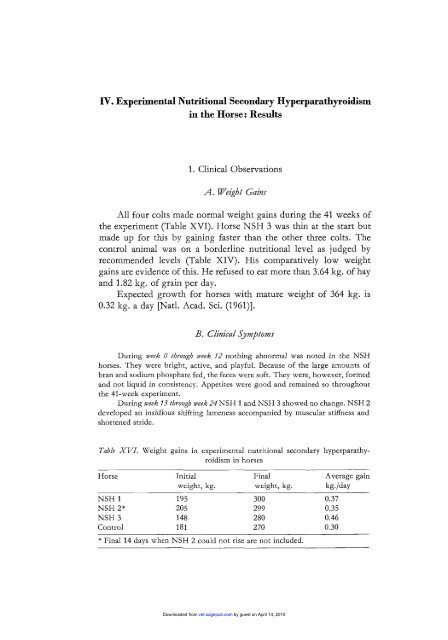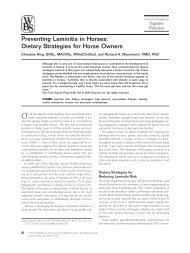Nutritional Secondary Hyperparathyroidism in the Horse
Nutritional Secondary Hyperparathyroidism in the Horse
Nutritional Secondary Hyperparathyroidism in the Horse
Create successful ePaper yourself
Turn your PDF publications into a flip-book with our unique Google optimized e-Paper software.
IV. Experimental <strong>Nutritional</strong> <strong>Secondary</strong> <strong>Hyperparathyroidism</strong><br />
<strong>in</strong> <strong>the</strong> <strong>Horse</strong>: Results<br />
1. Cl<strong>in</strong>ical Observations<br />
A. Weight Ga<strong>in</strong>s<br />
All four colts made normal weight ga<strong>in</strong>s dur<strong>in</strong>g <strong>the</strong> 41 weeks of<br />
<strong>the</strong> experiment (Table XVI). <strong>Horse</strong> NSH 3 was th<strong>in</strong> at <strong>the</strong> start but<br />
made up for this by ga<strong>in</strong><strong>in</strong>g faster than <strong>the</strong> o<strong>the</strong>r three colts. The<br />
control animal was on a borderl<strong>in</strong>e nutritional level as judged by<br />
recommended levels (Table XIV). His comparatively low weight<br />
ga<strong>in</strong>s are evidence of this. He refused to eat more than 3.64 kg. of hay<br />
and 1.82 kg. of gra<strong>in</strong> per day.<br />
Expected growth for horses with mature weight of 364 kg. is<br />
0.32 kg. a day [Natl. Acad. Sci. (1961)l.<br />
B. Cl<strong>in</strong>ical Symptoms<br />
Dur<strong>in</strong>g week 0 through week I2 noth<strong>in</strong>g abnormal was noted <strong>in</strong> <strong>the</strong> NSH<br />
horses. They were bright, active, and playful, Because of <strong>the</strong> large amounts of<br />
bran and sodium phosphate fed, <strong>the</strong> feces were soft. They were, however, formed<br />
and not liquid <strong>in</strong> consistency. Appetites were good and rema<strong>in</strong>ed so throughout<br />
<strong>the</strong> 41-week experiment.<br />
Dur<strong>in</strong>g week 13 throzgb week 24 NSH 1 and NSH 3 showed no change. NSH 2<br />
developed an <strong>in</strong>sidious shift<strong>in</strong>g lameness accompanied by muscular stiffness and<br />
shortened stride.<br />
Table XVI. Weight ga<strong>in</strong>s <strong>in</strong> experimental nutritional secondary hyperparathy-<br />
roidism <strong>in</strong> horses<br />
<strong>Horse</strong> Initial F<strong>in</strong>al Average ga<strong>in</strong><br />
weight, kg. weight, kg. kg./day<br />
NSH 1 195<br />
NSH 2* 205<br />
NSH 3 148<br />
Control 183<br />
300<br />
299<br />
280<br />
270<br />
* F<strong>in</strong>al 14 days when NSH 2 could not rise are not <strong>in</strong>cluded.<br />
Downloaded from<br />
vet.sagepub.com by guest on April 14, 2010<br />
0.37<br />
0.35<br />
0.46<br />
0.30



